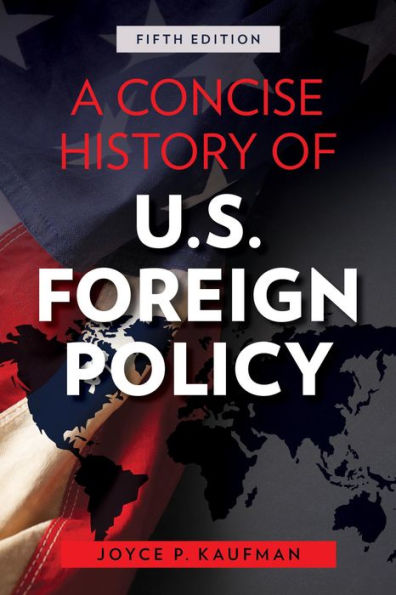Table of Contents
Preface to the Fifth Edition
Part I: The Framework
1 Setting the Stage for Understanding U.S. Foreign Policy
Introduction to U.S. Foreign Policy
What Is Foreign Policy?
National Interest
Foreign Policy Orientations
Unilateralism and Isolationism
Engagement/Internationalism
Theory and Context
Identifying Themes
Who Makes Foreign Policy, and Why Are Particular Decisions Made?
The Actors
Role of Economics
Role of Domestic Politics and Factors
Who Is Affected by U.S. Foreign Policy Decisions?
Impact of U.S. Foreign Policy Decisions on Other Countries
Domestic Constituencies
The “Powerless”: The Feminist Perspective
Setting the Stage
Primary Sources
Part II: The Formative Years
2 Unilateralism to Engagement: The Founding to the End of World War I, 1777–1920
The Beginning
Creating a Foreign Policy Framework
Beware of Entangling Alliances
Manifest Destiny, the Monroe Doctrine, and Westward Expansion
The War of 1812
The Monroe Doctrine
Continued Expansion
Mexican-American War
The American Genocide
Expansion into the Pacific
The Civil War
The Spanish-American War
Implications of the Spanish-American War
The Scramble for Concessions
The Roosevelt Corollary to the Monroe Doctrine
March to World War I
Wilsonian Idealism and U.S. Foreign Policy
Wilson’s Fourteen Points
U.S. Involvement in Russia
Domestic Issues: The Executive and Legislative Branches
The Shifting National Interest
Chronology from the Founding to the End of World War I
Selected Primary Sources
3 From Isolationism to Superpower: The Interwar Years through World War II, 1920–1945
Interwar America
U.S. Foreign Policy, 1920–1930
Escalation to World War II: 1930–1941
Neutrality Acts
From Neutrality to Nonbelligerency
War
Executive Order 9066
Preparing for Peace
The Impact of World War II
Technology and World War II
The Decision to Bomb Hiroshima and Nagasaki
The United Nations: Defining the Postwar World
Creation of the United Nations
From Isolationism to Engagement
The Domestic Context for the Postwar Period
Chronology, 1920–1945
Selected Primary Sources
Part III: The Cold War
4 The Making of a Superpower: The Evolution of U.S. Cold War Policy, 1945–1968
Background of the Cold War
The Early Years of the Cold War
George Kennan and Early Cold War Policy
1947: Outlining U.S. Cold War Policy
The Truman Doctrine
The National Security Act of 1947
The Marshall Plan
The Escalation of the Cold War: Berlin to Korea
The Creation of NATO
The End of the Decade
NSC 68
War in Korea
The Cold War at Home
The Domino Theory
Eisenhower
Doctrine of Massive Retaliation
The U-2 Incident
The Kennedy Years
Berlin
Cuba
Vietnam
Johnson: Vietnam, and the Great Society
The Tonkin Gulf Resolution
The Great Society
The End of the Decade: Changes in U.S. Policy
The 1960s into the 1970s
Chronology, 1946–1968
Selected Primary Sources
5 The Cold War Continued: Nixon through Reagan, 1969–1989
Nixon
Nixon and Vietnam
War Powers
The Soviet Union, Détente, and Arms Control
Nixon and Europe
China and Normalization
Gerald Ford
Carter
The Carter Administration: Successes and Failures
Reagan
From Cold War to Democratic Revolutions
Continuing the Arms Control Process
Iran-Contra
The Cold War and Beyond
Chronology, 1969–1988
Selected Primary Sources
Part IV: The Post–Cold War Period
6 The Period of American Hegemony: Bush-Clinton-Bush (1989–2009)
George H. W. Bush and the “New World Order”
The Persian Gulf War
The End of the Soviet Union
The Balkans and Ethnic Conflict
The Clinton Years
Somalia
Haiti
The Balkans
NATO Enlargement
Economics: Trade and Globalization
The Environment: The Kyoto Protocol
Terrorism
Rethinking U.S. Foreign Policy under Clinton
George W. Bush: From Election to 9/11
Contested Election and Implications for U.S. Foreign Policy
September 11 and the Responses
War with Afghanistan
The Bush Doctrine and the War with Iraq
The War with Iraq and Its Aftermath
Freedom and Democracy for All
President Bush and Wilsonian Idealism
The Iraq War: A Postscript
Chronology 1989–2009
Selected Primary Sources
7 Obama and Trump: 2009 to 2021
President Obama and his Foreign Policy Direction
The Obama Administration in Retrospect
Challenges Facing the Obama Administration
Obama and Iraq and Afghanistan
Relations with the Middle East
Ties to the Islamic World
Iran and the Nuclear Arms Deal
The United States and Israel
The “Arab Spring” and Civil War in Syria
U.S. Relations with Other Parts of the World under Obama
Relations with Russia
U.S. Relations with Europe
“Pivot to the Pacific”
U.S. Relations with Africa
Other Challenges to the United States under Obama
Obama’s Legacy
The Election of Donald Trump
An “America First” Foreign Policy
The Early Outlines for a Trump Foreign Policy
The Political Emergence of Donald J. Trump
Coronavirus Pandemic
U.S. Relations with Russia
U.S. Relations with the Western Allies
U.S. Relations with China under Trump
North Korea
The Middle East
Other Noteworthy Foreign Policy Issues
U.S. Foreign Policy Post-Trump
Chronology 2009–present
Selected Primary Sources
8 Biden and Beyond: The Future of U.S. Foreign Policy
The Election of 2020 and the Transition
The Challenges and Threats
U.S. Relations with other Nations
Relations with China
The United States and the Iran Nuclear Agreement
The United States, Russia, and Arms Control
Relations with Europe
Other Threats
Threats from Disease: Pandemics
Climate Change
The Future of U.S. Foreign Policy: Returning to First Principles
The Cold War as a Framework for U.S. Foreign Policy
The Changing Notion of Power
U.S. Power and National Interest
The Changing Notion of Threat
The Actors and the Domestic Balance of Power
Challenges to U.S. Foreign Policy in the Future
Selected Primary Sources
Notes
Index
About the Author



